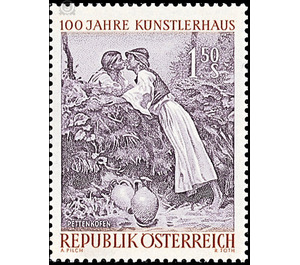100 years - Austria / II. Republic of Austria 1961 - 1.50 Shilling
Theme: Art & Culture
| Country | Austria / II. Republic of Austria |
| Issue Date | 1961 |
| Face Value | 1.50 |
| Color | violet |
| Printing Type | Typography |
| Stamp Type | Commemorative |
| Item Type | Stamp |
| Chronological Issue Number | 431 |
| Chronological Chapter | OOS-OE2 |
| SID | 11221 |
| In 57 Wishlists | |
The second stamp of this series shows the painting "The Kiss" by August von Pettenkofen. The very popular oil painting was created in 1864 and is located in the Kunsthistorisches Museum. It's a typical Hungarian genre picture that shows us a guy and a girl bending over a low fence to kiss each other. Pettenkofen succeeded in liberating the Viennese genre picture of Vormärz from its local limits. He was already looking for the great connection with European art and presented with his pictures the last highlight and conclusion of the Viennese genre art dar. The moral picture conspired, the artist felt, especially from the picturesque Pussta with their girls, boys and fiery horses, vom romantic, restless existence of the gypsies attracted; he loved the varied coloristic charms of this peculiar atmosphere. With his painting style, loosened up in the spirit of French impressionism, he spent his entire life trying to cope with the problem of light that had been a major theme of landscape painting ever since Waldmüller.


